Playing From A Hymnal
Introduction
Until now, we have only examined improvisation based on simple music. While this is very similar to improvising from a lead sheet or fake book, it is not the same as reading music from a hymnal. Hymnals are written in a style of their own. It is the goal of this section to familiarize ourselves with the different styles of print found in song books, so that we may be ready to play from any book we are given.
Notation
Hymnals have, for some reason, become a haven for oddities of printed music. Often, these peculiarities are nothing more than an older style of music engraving, but, if one is not accustomed to seeing that particular style of notation, it can cause unnecessary confusion and frustration.
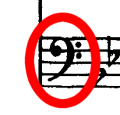 |
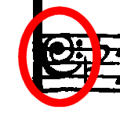 |
| Modern Bass Clef |
Hymnal Bass Clef |
While not common in the newer hymnals, older hymnals will often have a different style of Bass Clef design. The modern bass clef sign is shown on the right, as well as the older bass clef style, which can only be described as "backward." Do not fear, though, for all note names are still the same, even if the older version of the "F Clef" appears as though it should be named the "Curly Cue Clef."
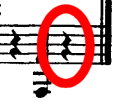 |
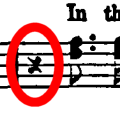 |
| Modern Quarter Rest |
Hymnal Quarter Rest |
Rests have also changed form through time, particularly the quarter rest. In modern music, the quarter rest appears as a squiggly (I'm sure this is a proper description) line, as seen on the left. Below it is the older, but often used, hymnal version. The danger here is that the older-style quarter rest looks very similar to the modern eighth rest, a mistake which could confuse the rhythm and counting of the novice player.
Note Groupings
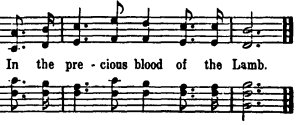 |
| Difficult To Read Rhythm |
One of the more challenging aspects of playing from a hymnal is that it is difficult to recognize the groupings of eighth and sixteenth notes in a measure, because older hymnals do not make common use of beamed notes. Look at this excerpt from the last line of There Is Power In The Blood. Each note is spaced evenly in the measure, whether it is an eighth note, quarter note, dotted eighth note, or sixteenth note.
Should the pianist be familiar with a song, then this difficulty can be easily overcome, but as a church pianist, one will often be called upon to perform daunting tasks, including (but not limited to) having to sight read a fast song in 12/8 with odd rhythms, transposing it down a step and a half, and adding in spontaneous fermatas at the whim of the Music Director. Perhaps this is a bit exaggerated, but hopefully I have made my point clear. Thankfully, many of the modern hymnals are beginning to make regular use beams for groups of eighth and sixteenth notes, but there are still more churches than not who will not take advantage of these newer books for some time.
Vocal Direction
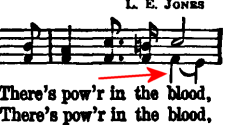 |
| Slur Used For Vocal Direction |
Hymnals were written for singers, therefore, some musical devices which would serve other purposes in classical music are, in hymnals, adapted to give instruction to the singers. Such is the case with the slur. In classical music, a slur directs which notes are to be played connected and smooth. In hymnals, this mark is used to indicate to the singers that the notes connected by the slur will be sung on the same word or syllable.
I stated earlier that many times older hymnals do not use beamed eighth and sixteenth notes. There are some hymnals, however, that will use beams instead of a slur when the notes change but the words do not, and the note values are capable of being beamed (i.e., not a quarter note, half note, etc.).
Incomplete Measures
Hymnals are notorious for splitting up measures in odd places. This is usually done so that words can be grouped on a particular line. Remember, hymnals were written for singers, and most singers will watch the words far more than they will keep track of the rhythm, so Editors tailor verse and chorus layouts to meet the needs of the congregation, not the instrumentalist. As for the pianist, usually the knowledge of this occurrence is sufficient to avoid difficulty in playing. Just consider this to be another quirk which makes playing from a hymnal a special ability.
Shaped Notes
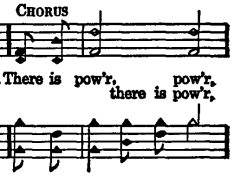 |
| Shaped Notes In A Hymnal |
Given the short paragraphs and limited scope of this section, I cannot fully explain nor express the history and importance of shaped notes in hymnals. As one can see in this example to the left, each note has a distinctive shape (hence the name "shaped notes"). The important thing to know when dealing with shaped notes is that they can easily be read in the same manner as traditional notation. The shapes do have additional meaning, but one is not required to know this in order to play the music. For the beginning church pianist, it is important to be aware of the shaped note system so that one will not be confused when attempting to play music written in this style. On a side note, I had thought that shaped notes were no longer in popular use, but I have recently acquired a new hymnal printed entirely in this classic, "shapely" style.
"Updated" Hymnals
I include this last paragraph simply as a warning to church pianists when switching between or permanently converting to a different hymnal. Simply stated, all hymnals are not created equal. If you are used to playing from an older hymnal, then watch out for the more modern hymnals (usually 1970's and up) that make regular practice of re-writing hymns in different keys, altering melodies and harmonies, and make other, unannounced editorial renovations to hymns. While experienced pianists can adapt and overcome, novice musicians can be easily flustered and side tracked by these little surprises.
